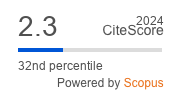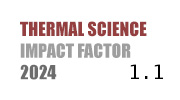ABSTRACT
To reveal the influence of using gradient oxygen-enhanced combustion on the gas-flow, combustion status, heat transfer and NOx emission in glass furnace, numerical simulation on the flame space of an actual float glass furnace with air combustion was conducted. The streamline of combustion-supporting gas and flue gas was displayed, the temperature distribution and heat transfer performance in the flame space were analyzed, and the mechanism of NOx emission reduction by gradient oxygen-enhanced combustion was explored. The comparative study between air combustion and gradient oxygen-enhanced combustion showed that there is not much difference in the streamline and temperature distribution in flame space, which ensures the stability of working state in furnace. Compared with air combustion, the temperature of the batch zone was increased by using gradient oxygen-enhanced combustion, and the high temperature combustion zone was closer to the glass surface, which increases the radiant heat flux to the glass surface. In addition, the NOx emission concentration in flue gas at the outlets was reduced by 17.1%. The results obtained in this study not only provide important theoretical guidance for gradient oxygen-enhanced combustion in glass furnace, but also lay a foundation for further research about advanced combustion mode to save energy and reduce emissions.
KEYWORDS
PAPER SUBMITTED: 2024-10-01
PAPER REVISED: 2024-11-21
PAPER ACCEPTED: 2024-11-30
PUBLISHED ONLINE: 2025-01-09
THERMAL SCIENCE YEAR
2025, VOLUME
29, ISSUE
Issue 4, PAGES [2627 - 2640]
- Wang, J., Application and Comparison of SCR, SNCR and SNCR/SCR Flue Gas Denitration Technology (in Chinese), Electric Power Technology and Environmental Protection, 34 (2018), 5, pp. 35-36
- Beerkens, R., et al., Reduction of NOx Emissions in Regenerative Fossil Fuel Fired Glass Furnaces: a Review of Literature and Experimental Studies, Glass Technology, 49 (2008), 6, pp. 279-288
- Zhao, E., et al., A Section Gradient Oxygen-increasing Combustion Assistance Technology Of Float Glass Furnace for Reducing Emission of NOx (in Chinese), Glass, (2013), 5, pp. 12-15
- Pedel, J., et al., Oxygen Enhanced NOx Reduction (OENR) Technology for Glass Furnaces, Proceedings, 75th Conference on Glass Problem, Greater Columbus Convention Center, Columbus, O., USA, 2014, pp. 3-6
- Huang, Z., Mu, Z., The Improve Design for Glass Furnace Melter End and Working End of Gradient Increase Combustion Oxygen (in Chinese), Glass, (2019), 4, pp. 21-26
- Huang, Z., Mu, Z., The Improve Design for Glass Furnace Regenerator of Gradient Increase Combustion Oxygen (in Chinese), Glass, (2018), 9, pp. 17-21
- Alan Pools, W., Mathematical Modeling of Glass Melting Systems, Am Ceram Soc Bul, 83 (2004), 1, pp. 25-27
- Dankert, T. K., Tuson, G. B., Demonstration on an Ultra-Low-NOx Oxygen-fuel Glass Melting System, Ceram Eng Sci Proc, 17 (1996), 2, pp. 47-54
- Boineau, P., et al., Numerical Simulation of a Batch Metallurgy Furnace Equipped with Flameless Oxidation Regenerative Burners, Revue De Metallurgie, 104 (2007), 3, pp. 142-148
- Manoj, K. C., et al., Mathematical Modeling of Flow and Heat Transfer Phenomena in Glass Melting, Delivery, and Forming Processes, International Journal of Applied Glass Science, 1 (2010), 2, pp. 45-48
- Karimi, H. J., Saidi, M. H., Heat Transfer and Energy Analysis of a Pusher Type Reheating Furnace Using Oxygen Enhanced Air for Combustion, Iron and Steel Research International, 17 (2010), 4, pp. 12-17
- Mette, B., et al., Numerical Simulations of Staged Biomass Grate Fired Combustion with an Emphasis on NOx Emissions, Energy Procedia, 75 (2015), Aug., pp. 156-161
- Hou, X., et al., CFD Simulation of Combustion in Gas Turbine Engine, Proceedings, 5th International Conference on Frontiers of Manufacturing Science and Measuring Technology, Taiyuan, China, 2017, Vol. 6, pp. 890-896
- Dekterev, A. A., et al., Numerical Simulation of Liquid Hydrocarbon Fuel Burning in a Direct-flow Evaporation Burner in a Jet of Superheated Steam, Proceedings, 35th Siberian Thermophysical Seminar (STS), Novosibirsk, Russia, 2019, pp. 8
- Fordoei, E. E., et al., Numerical Study on the Heat Transfer Characteristics, Flame Structure, and Pollutants Emission in the MILD Methane-air, Oxygen-enriched and Oxy-methane Combustion, Energy, 218 (2021), 119524
- Mei, S., et al., Numerical Simulation of the Complex Thermal Processes in a Vortexing Precalciner, Applied Thermal Engineering, 125 (2017), Oct., pp. 652-661
- Mei, Z., et al., Influences of Reactant Injection Velocities on Moderate or Intense Low-Oxygen Dilution Coal Combustion, Energy & Fuels, 28 (2014), 1, pp. 369-384
- Weber, R., et al., On the (MILD) Combustion of Gaseous, Liquid, and Solid Fuels in High Temperature Preheated Air, Proceedings of the Combustion Institute, 30 (2005), 2, pp. 2623-2629
- Diaz-Ibarra, O., et al., Design of a Day Tank Glass Furnace Using a Transient Model and Steady-State Computation Fluid Dynamics, Applied Thermal Engineering, 52 (2013), 2, pp. 555-565
- Szymczyk, J., et al., Improvement of Energy Efficiency of Natural Gas Combustion by Applying a Homogeneous Combustion, E3S Web of Conferences, 17 (2017), May, pp. 93-96
- Banerjee, A., et al., Simulation of Combustion Space Heat Transfer of Glass Melting Furnace, Heat Transfer-Asian Research, 46 (2016), 6, pp. 569-584
- Abbassi, A., Khoshmanesh, K., Numerical Simulation and Experimental Analysis of an Industrial Glass Melting Furnace, Applied Thermal Engineering, 28 (2008), 5-6, pp. 450-459
- Simcik, M., Ruzicka, M. C., CFD Model for Pneumatic Mixing with Bubble Chains: Application to Glass Melts, Chemical Engineering Science, 127 (2017), May, pp. 344-361

